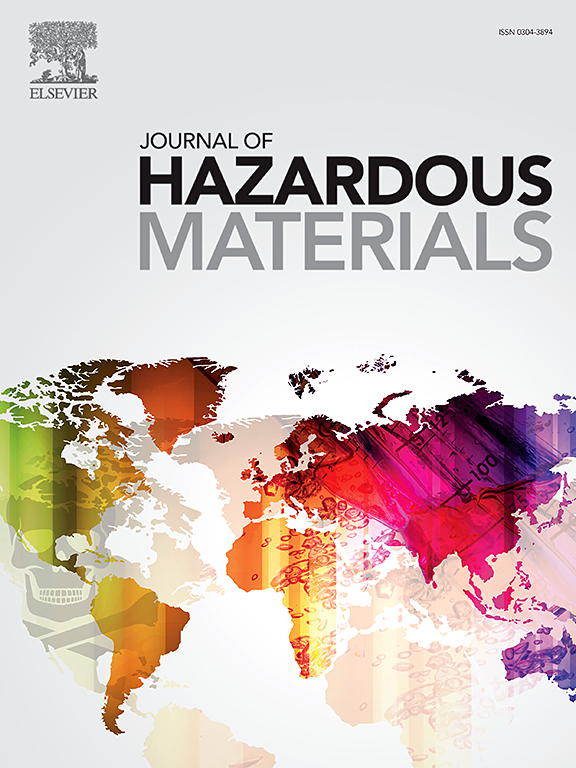生物炭衍生的溶解黑碳的辐照依赖性、光降解动力学和分子进化机制
IF 11.3
1区 环境科学与生态学
Q1 ENGINEERING, ENVIRONMENTAL
引用次数: 0
摘要
光化学控制着水生环境中溶解的黑碳(DBC)的命运,往往导致负面的环境影响。然而,在光降解反应中DBC组分的动态变化在很大程度上仍未被探索。在此,我们提出了一种新的DBC成分的光降解机制,通过使用高分辨率质谱和光谱结合二维相关、样品间排序和分子网络分析来评估它们的辐照依赖性、光降解动力学和分子进化。类木质素和缩合芳香分子是DBC的主要基团。随着辐照时间的增加,DBC中的官能团呈现出O-H拉伸的顺序响应;醇/醚/碳水化合物的C-O拉伸烯烃的C-H拉伸/羧酸的c -COO拉伸>蛋白质中酰胺的C= 0)。DBC分子在辐照过程中由不饱和氧化分子转化为饱和还原分子,这是由独特分子的化学转化网络所揭示的。在光降解过程中,具有黄嘌呤样荧光的组分以及木质素样和凝聚芳香分子被确定为光不稳定组分,而饱和分子在光稳定组分的光降解反应(如键裂解和光氧化)中发挥重要作用。这些发现增强了我们对DBC在生态系统中的环境行为的理解。本文章由计算机程序翻译,如有差异,请以英文原文为准。

Irradiation-Dependent Properties, Photodegradation Dynamics, and Molecular Evolution Mechanism of Biochar-Derived Dissolved Black Carbon
Photochemistry controls the fate of dissolved black carbon (DBC) in aquatic environments, often leading to negative environmental impacts. However, the dynamic changes in DBC components during photodegradation reactions remain largely unexplored. Herein, we propose a novel photodegradation mechanism for DBC components by evaluating their irradiation-dependent properties, photodegradation dynamics, and molecular evolution using high resolution mass spectrometry and spectroscopy combined with two-dimensional correlation, inter sample ranking, and molecular networking analyses. Lignin-like and condensed aromatic molecules were predominant groups in DBC. As irradiation time increased, the functional groups in DBC displayed a sequential response of O-H stretching of phenolic > C-O stretching of alcohols/ethers/carbohydrates > C-H stretching of alkenes/(-COO stretching of carboxylic acids > C=O of amide in proteins). DBC molecules transformed from unsaturated and oxidized molecules to saturated and reduced molecules during irradiation, as revealed by the chemical transformation networks of unique molecules. Components with fulvic-like fluorescence, along with lignin-like and condensed aromatic molecules, were identified as photo-labile fractions during photodegradation, while saturated molecules could play an important role in the photodegradation reaction (e.g., bond cleavage and photooxidation) of photo-stable fractions. These findings enhance our understanding of the environmental behaviors of DBC in ecosystems.
求助全文
通过发布文献求助,成功后即可免费获取论文全文。
去求助
来源期刊

Journal of Hazardous Materials
工程技术-工程:环境
CiteScore
25.40
自引率
5.90%
发文量
3059
审稿时长
58 days
期刊介绍:
The Journal of Hazardous Materials serves as a global platform for promoting cutting-edge research in the field of Environmental Science and Engineering. Our publication features a wide range of articles, including full-length research papers, review articles, and perspectives, with the aim of enhancing our understanding of the dangers and risks associated with various materials concerning public health and the environment. It is important to note that the term "environmental contaminants" refers specifically to substances that pose hazardous effects through contamination, while excluding those that do not have such impacts on the environment or human health. Moreover, we emphasize the distinction between wastes and hazardous materials in order to provide further clarity on the scope of the journal. We have a keen interest in exploring specific compounds and microbial agents that have adverse effects on the environment.
 求助内容:
求助内容: 应助结果提醒方式:
应助结果提醒方式:


